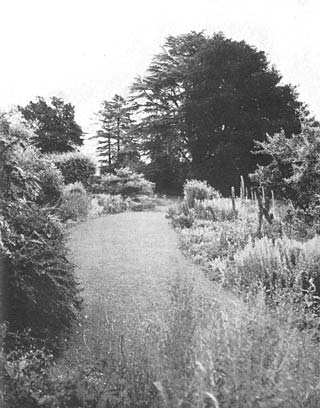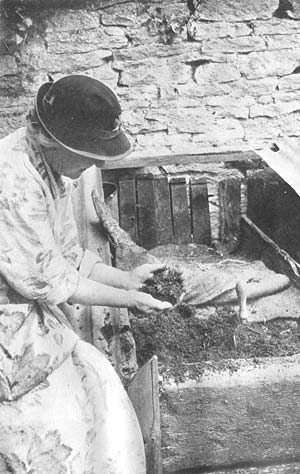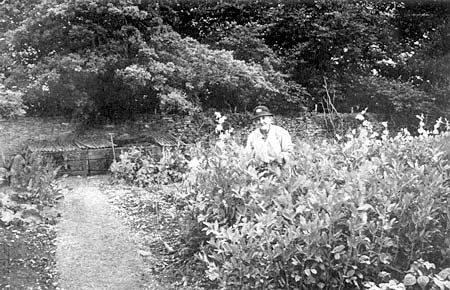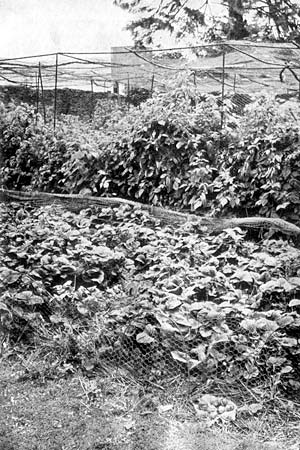The building of the heap may sound laborious! As a matter of fact, it is very simple, it soon fits into the routine of garden work, and always carries with it a sense of anticipation. Opening a ripe heap never loses its thrill of amazement! The change is so dramatic, the aroma so sweet and satisfying, the soil so clean and vital, one cannot keep one's fingers away from it. But I am not sure that the results of using the compost in the garden are not even more astounding.
It gives the soil whatever quality it lacks, no matter what it may be! It transforms heavy clay into friable mould; it gives thin soil substance, and hungry soil food. It suits every kind of plant. A clever Dutchman, an expert on soil, explained that point, in his slightly broken English: 'But of course -- do you not see? You are not giving to your plants one dish. You are offering them a restaurant and they can choose for themselves.'
It is easy to use. Keep it in the top four to six inches of the soil, and either fork or 'cultivate' it in. It is soil, and will amalgamate quickly with its surroundings. Use it at about six tons per acre; the equivalent is two and a half lb. per square yard. The quantity is approximate. You can't hurt the land by using too much. It will never make it sour, so you can be generous to hungry land and to hungry plants.
In intensive gardening, where crop follows crop, fork in a fresh dressing of compost, as you plant each successive one (other than roots, of course). If you are short of it, give a little, to each individual plant.

Plate 4. 'It will be rich dark soil'

Plate 5. In the flower garden: 'A vista of colour bordering
a broad turf walk curving in harmony with the wall'
A good mixture for seed boxes and frames is
Loam, 5 parts; compost, 2 parts; sand, 1 part.
For seed drills: line the drill with a sprinkle of sifted compost and sand.
Tomatoes in Pots
Start with the normal mixture, loam 5 parts, compost 2 parts. Plant low in the pot -- the soil level about half-way up. When the roots appear on the surface put two inches of top dressing:
1st dressing: 4 parts loam; 3 parts compost.
2nd dressing: 3 parts loam; 4 parts compost.
3rd dressing: 2 parts loam; 5 parts compost.
When the first truss sets and is the size of a golf ball, use pure compost. When the fruit is ripening, give either manure or compost water, every ten days. When the roots grow out of the drainage holes, put compost on the stage. This method has proved most successful.
Special Uses
For peas and beans we mix a layer of compost into the top of the second spit to hold the moisture, and of course add the usual dressing to the top soil.
It makes a perfect mulch for soft fruit, greedy vegetables, and wall fruit.
For feeding orchard trees, we make up a strong brew of 'manure water' from the fresh manure tub (see above, Chapter 3, The Manure Tub) (or compost water) one gallon manure to twenty gallons water. We fill a wheel water-barrel with the strong mixture, dilute it to tea colour for use (roughly one pint to one gallon of water). We run a fork straight into the soil, at three-foot intervals, round the outside stretch of the branches and pour one gallon of the liquid into the the holes. This is done in early spring.
The result is amazing. Old tired trees (the orchard is very old) have taken a new lease of life, with vigorous healthy foliage, and bear outstandingly good crops.
Before the war I had a staff of three men: a chauffeur-handyman, who also mowed the lawns, and two men in the garden. There is a kitchen garden of three-quarters of an acre and two glass houses, besides many fencing jobs on the farm and round the woods. The place is 150 acres, of which 50 are woodland. The farm was let for grazing, but the woods and fences are my responsibility. The fences are mostly dry Cotswold walls, so the men were busy.
My own garden work was entirely the flower garden -- now a place of beauty. The whole of the enclosure is protected on the north side by the curving grey wall. It was always a vista of colour bordering a broad turf walk, curving in harmony with the wall; green lawns were dominated by a group of trees, including a copper beech, and a marvellous cedar; all this in a setting of woods and hills with a view down the Golden Valley giving both vista and space.
The sole care of this garden, plus the compost work in all its branches, filled most of every day. The kitchen garden, and fruit, was left entirely to the gardener. He made his own compost, at first grudgingly and without much care. He was 'set in his own ways' and his results were not first-rate, till one day, he confessed he had no compost fit for use -- what was he to do? I told him to use one of my heaps, from the 'garden' yard, and left him to it. When I next saw him his face was wreathed in smiles. 'The best stuff I have ever handled, Miss!' After that, there was more care and better results.
One half of the kitchen garden had been literally carved out of a field. The soil was originally two inches in depth, then came rock! We pick-axed it out, three feet deep -- pure, Cotswold stone -- tons of it -- and then had to fill up with whatever we could get. It came from old field dumps, from the woods, and the roadsides; a stupendous task and a weird mixture, but the compost pulled it together and today it is a good garden, though still a stony one.
In 1940 the whole staff joined up, and in their place I had one very old man; an odd job labourer, well over seventy, crippled in both hands, and lame. A gallant old fellow, who talked such broad 'Gloucestershire' that at first I couldn't understand him, he was a first-rate stonewaller (a Cotswold craft), good at straightforward digging, but beyond that not much of a gardener. The cry then, as now, was 'Dig for Victory', so all my efforts went to the kitchen garden, and the flowers had to look after themselves.
I had a lot to learn and I loved it. I made and used far more compost than the garden had been having and some of the results were startling.
Strawberries
I had been told that strawberries would not grow on the Cotswolds, certainly they had never succeeded hitherto. I divided some old plants, took a few runners, made a rich bed, heavily composted, rammed the friable earth till it was firm. (They like hard planting.) After the first year they were a wonderful sight: healthy, large plants roped with berries, immense and very sweet. Everyone coming to the garden would stop, and gasp, 'Oh, LOOK at the strawberries!'

Plate 6. 'Oh look at the strawberries'

Plate 7. In the kitchen garden. Note the bins and the stony soil.
This is an outstanding case, but looking back on the garden as a whole, the general appearance of the crops has been consistently good. I remember a delightful instance before the war. A party of professional gardeners came to see the compost and its results. They started politely but frankly sceptical; when they reached the kitchen garden there was a silence: we came into view of the asparagus bed (the month was September). A voice said: 'Coo! Look at they! I thought they was young larches!' We went on and there were a few murmured words of appreciation. When we had done the rounds, the leader, with a charming gesture, took off his hat and said, 'Well, Miss -- I have learnt something. You often see one or other good healthy crop, but you very seldom find all the crops equally healthy. You've got that, here. There's something that's all right. Thank you.' He was an old man and it meant a lot. Incidentally, one of the party became a gardener to a nursing home on the Cotswolds and the Q.R. system is used as a matter of course -- and success.
Weather Resistance
This is important in England and the resistance to extremes of weather was proved in the severe winter of 1940. Frost, a partial thaw, then a fine rain that fell -- and literally froze as it fell. Every blade of grass became a column of clear ice. Every twig was coated with inches of ice. Birds froze on the trees. Branches crashed every few minutes, borne down by sheer weight of ice, and in falling broke those beneath them. We woke to a world of clear ice, great beauty, and appalling devastation.
Visiting gardeners during the following summer told me they had lost 90 per cent of their brussels sprouts. The crop in this garden came through undamaged -- and the vegetable garden faces north at an altitude of 750 feet.
Resistance against drought is also noteworthy. In this stony friable soil, we would welcome rain every week! But now the soil holds the moisture and the plants flourish even in a prolonged drought.
Pest Resistance
One of the happiest results of this vegetable manure is increased resistance to pests and disease.
It is common sense, of course! If plants (like humans) are well fed and full of vitality, they withstand diseases. Disease or pests may show themselves, but they do not get the upper hand.
Even in the worst cabbage butterfly years, when caterpillars reduced plants to skeletons, only a few scattered holes showed amongst the compost-grown brassica. One theory is that the marauders eat a little, and are satisfied, while with devitalized plants, 'they go on eating, seeking for something that is not there', till they have destroyed the whole.
The 'Old Man' soon became a convert; his wife is a good gardener, and together they made compost for their own plot. Last year onion mildew was rampant in his village, and he told me that his two immediate neighbours lost the whole of their crops: his rows escaped without a touch of the disease. He added that he had only been able to compost half his row of beans, and -- 'Thee could'st tell to an inch, where us left un off.'
A correspondent from Nottingham wrote that ground pests had played havoc all round the countryside. His plot was in the centre of three ravaged gardens -- yet it came through unscathed, and, what was more striking, a friend of his lost every plant in his garden with the exception of some cabbage plants, raised on compost, and given to him by the writer.
An equivalent to this happened here during a season when blue aphis was prevalent. After a careful survey, I found only 3 per cent of my brassica were attacked. Of these only three were my own plants, in each case weaklings with double stems, that should not have been planted out. The rest were plants given to me from a non-composted garden.
So the evidence grows, and is repeated from many sources.
Now -- what about quality?
Quality
Size alone is nothing. The supreme test is taste, texture, and feeding qualities.
I recall a young visitor who blew in one morning to see the garden and the compost. He was an enthusiast -- almost sang the praises of a certain shop that sold compost-fed vegetables. Never was there such food! It was a revelation! We discussed this and many matters till the morning flew. and the lunch bell rang. 'Come in and take pot-luck,' I said. He accepted, and we sat down. The vegetable was spring cabbage. He was talking eagerly. Suddenly he stopped short and realized what he was eating; he took a second mouthful, then a third, in complete silence. Then he laid down his fork, leant over the table, and said impressively, 'Miss Bruce, this has the -- -- beat to a frazzle!'
It is a curious fact that while ordinary cabbage smells when cooking, a compost-fed cabbage does not smell at all. There is a delicious, subtle sweetness about all the vegetables and fruit -- a curious reminder in taste, of the aroma of the compost itself. It is noticed, and commented on, by all visitors (even those who know nothing about the garden). It is eagerly recognized by those who use compost themselves. It is also discernible in the honey from the garden hives.
A passing visitor from Birmingham told me this story. He had been a keen Q.R. compost maker for three years, and was convinced of the different taste, and better quality of his own home-grown vegetables but, fearing his enthusiasm, he wanted an outside and conclusive proof. So one morning, instead of getting the potatoes from the garden, he secretly bought them from the greengrocer. At the midday meal he watched his wife. She ate a little, looked puzzled and dissatisfied, and finally said, 'What potatoes are these?' He answered grimly, but truthfully, 'They came from a different row.' After a time, when she showed obvious distaste, he remarked, 'You don't seem to be getting on with your potatoes, my dear. What is wrong?'
She burst out, 'Well, they are entirely different from the ones we have been having. They have no taste, they are exactly like the stuff we used to buy at the shop!' He had his proof. He confessed his trick, and both are more compost-minded than ever.
From a commercial point of view this aspect is very valuable. A smallholder specializing in compost-grown vegetables should, and does, command top prices.
One composter told me that a local greengrocer was so struck with the produce of his garden, that he offered him retail prices for all the vegetables he could supply.
A smallholder, running his garden on the French intensive system, wrote that he had solved the problem of the early market by the combination of 'Cloche and Compost'. He had got ten shillings a pound on open market for very early peas.
The comment of the tenant-farmer who now tills my land, is illuminating: 'There's something in it! Here's these fields, just the same land, let for twelve shillings an acre -- and there's the garden growing crops as if it were land worth five pounds an acre!'
A chance seed of wheat was dropped by a bird in a corner of the garden. It grew magnificently, had forty stems like young bamboos, and yielded two ounces of seeds.
The farmer lives ten miles away and has to bring his team of workers by lorry. He has not the available local labour to make farm compost heaps; but after threshing, my 'Old Man' made up several heaps of straw, cavings, weeds, and a little manure. They were treated, and the farmer tried them on a breadth of field, to be sown with oats. The stooks on this part of the field stood a foot higher than the rest, and the grain was infinitely heavier.
The foreman was thrilled, and he and several of the hands begged for some compost, to put into their own gardens.
Feeding Quality
This is the most important matter of all. If a plant is healthy, and growing up to its own perfection, it must have great vitality, and it is the vitality, the living force of the plant, that heightens its food value. The satisfying quality of the vegetables is noticed by all visitors, and is of value in these days of rationing. A vegetable cannot give what it has not got; what it has, it gets from the soil. It cannot reach its 'own perfection' in starved ground, still less in ground doped with chemicals.
Most artificials are soluble salts, so strong that a warning is given to avoid touching the foliage, for fear of burning it. (Lime is not an artificial fertilizer. It is a natural mineral. It does not dissolve and feed plants directly. It sweetens the soil and helps to release plant food.) The salts dissolve on the damp soil, or are watered in. The unfortunate plants are bound to absorb them. A burning salt solution! What harm can it not do? It may act as a stimulant, but to feed on a stimulant eventually ends in weakened constitution, disease and disaster.
Next:
5. Effect on Human Health
Back to the Small Farms Library Index